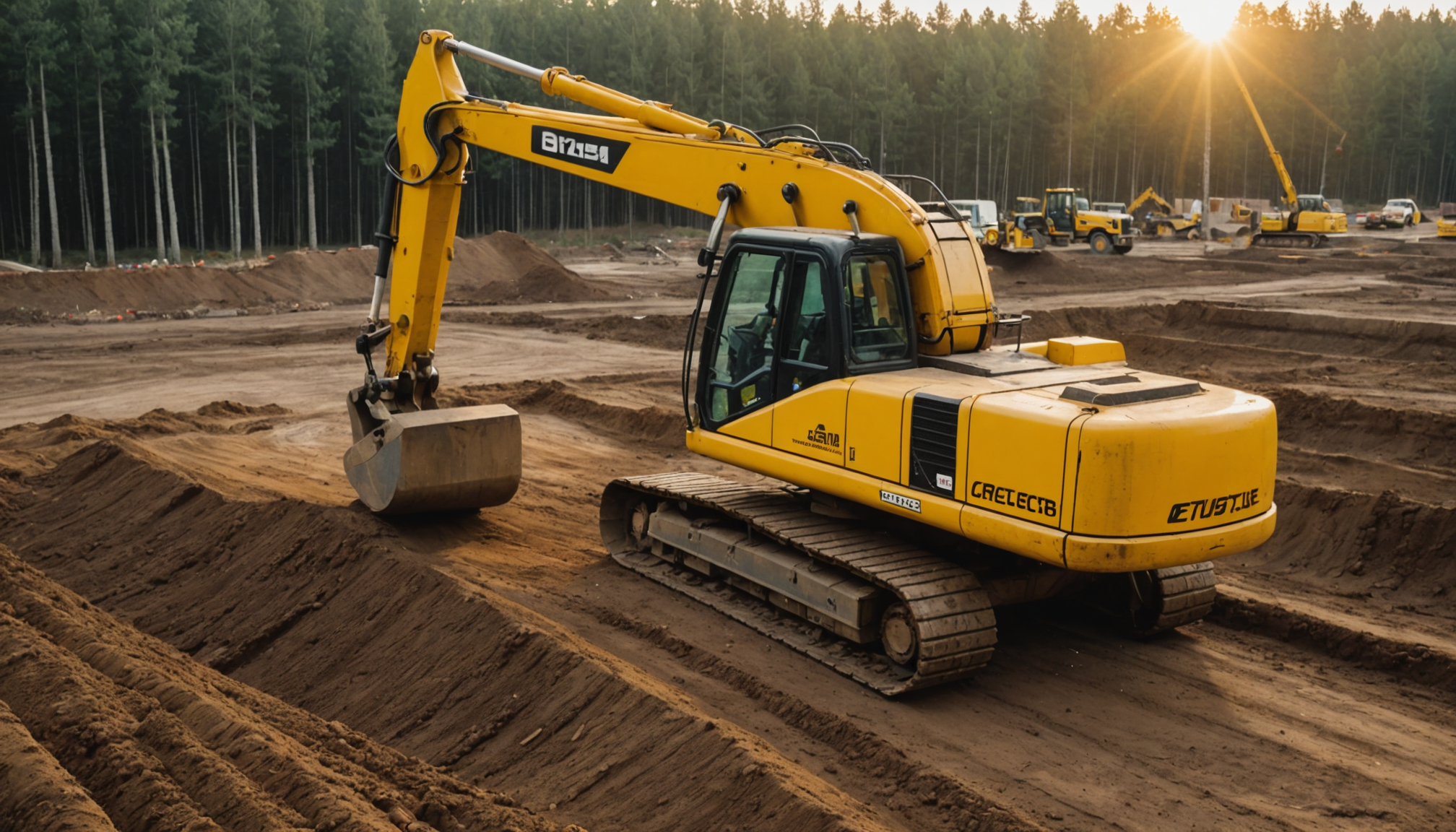Excavation plays a critical role in the construction industry, serving as the foundational phase upon which the success of a project is built. This initial step is vital because it ensures that other construction activities proceed smoothly and are structurally sound. At its core, excavation involves removing earth, rocks, and other materials from a specified area to create the space necessary for foundational elements, such as basements, footings, and utilities, to be installed correctly. By understanding its role, stakeholders can better appreciate the precision and expertise required to effectively execute this stage.
One of the primary purposes of excavation is to prepare the terrain for construction by achieving a stable foundation. A well-executed excavation process addresses potential issues like soil stability, drainage, and site grading. These factors are crucial for both the longevity and safety of the structure being built. For example, inadequate excavation can lead to issues such as settling, which may cause structural failures in the future. Furthermore, proper excavation ensures that water drainage is correctly implemented, preventing water from pooling around or under the structure, which can lead to erosion or damages.
Additionally, excavation is pivotal in defining the scope of a construction project. This process involves setting accurate boundaries that dictate where construction activities can and cannot occur, adhering to local zoning laws and environmental regulations. Proper demarcation helps avoid encroachment on neighboring properties and minimizes the project’s impact on existing natural conditions.
Moreover, excavation is integral to site logistics. During the preparation phase, critical infrastructure elements like access roads, storage areas, and machinery setups are determined by the initial excavation strategy. A thoroughly planned excavation can mitigate site access challenges, enhance the movement of materials, and optimize equipment placement. Such logistic efficiencies can translate to more streamlined operations and lower overall project costs.
| Aspect | Role in Excavation |
| Soil Stability | Ensures the ground can support structures without excessive settling |
| Drainage | Prevents water accumulation, protecting the structure from erosion |
| Boundary Accuracy | Ensures construction does not encroach on restricted areas |
| Site Logistics | Improves material and machinery flow throughout construction |
Therefore, recognizing excavation’s multifaceted role is essential for any successful construction project. Not only does it lay the groundwork for physical structures, but it also aligns the development with legal, environmental, and logistical considerations crucial for sustainable and efficient project execution.
Assessing site conditions for effective excavation
Assessing site conditions is a critical preparatory step that ensures the effectiveness of the excavation process. This evaluation must be comprehensive, taking into account multiple environmental and structural factors to mitigate potential challenges and adapt strategies appropriately. Here’s a detailed breakdown of how to carry out a thorough site assessment for effective excavation:
- Conduct a Preliminary Site Inspection
- Begin by visiting the site to get a firsthand view of the terrain. Look for obvious features such as existing structures, vegetation, and water bodies that may affect excavation.
- Identify any visible hazards or obstructions that may need to be addressed before excavation begins.
- Perform a Soil Analysis
- Test the soil composition by taking samples from various locations to understand its stability and load-bearing capacity.
- Determine soil type—such as clay, silt, sand, or gravel—as each type will influence the excavation method and equipment used.
- Assess the water content within the soil, as high moisture levels might require special drainage solutions or affect the excavation schedule.
- Evaluate Topography and Drainage Patterns
- Analyze the site’s topography to identify slopes and elevations that will impact excavation depth and approach.
- Study existing drainage patterns to ensure that planned excavation will not disrupt natural water flow, potentially causing flooding or erosion issues.
- Check for Underground Utilities
- Utilize utility mapping services to identify any buried cables, pipes, or other infrastructure which, if disrupted, could cause significant delays and incur extra costs.
- Contact relevant utility companies to mark utilities clearly on-site, if not already done.
- Review Legal and Environmental Regulations
- Ensure that all excavation plans comply with local zoning laws and environmental regulations to avoid legal issues.
- Investigate any protected areas or species that might be affected by excavation activities, ensuring adherence to conservation commitments.
- Identify Access Points and Logistic Considerations
- Determine how equipment and materials will access the site, planning roads or pathways if necessary.
- Consider site logistics such as storage for excavated materials and staging areas for machinery, ensuring minimal disruption to site operations.
This meticulous assessment provides a strategic foundation for the excavation process, ensuring that all potential obstacles are accounted for and the best excavation practices are deployed. By investing time and resources upfront to fully understand site conditions, project managers can anticipate challenges better, reducing the risk of unforeseen complications during excavation, and ultimately fostering a smoother construction progress.
Techniques and tools for precise excavation
Precision in excavation is achieved through a blend of advanced techniques and the deployment of specialized tools. Leveraging modern technology and engineering practices, construction teams can enhance the accuracy and efficiency of excavation projects, thereby setting the stage for successful project execution.
Laser-guided and GPS-controlled equipment are game changers in precise excavation. Machines equipped with these technologies can execute tasks with unmatched accuracy, ensuring that excavation depths and contours adhere strictly to the project specifications. GPS systems allow operators to receive real-time data and make adjustments on the fly, effectively reducing human error and minimizing material waste. This level of precision not only assures quality but also accelerates project timelines by eliminating the need for constant manual measurements and adjustments.
Furthermore, hydraulic excavators and backhoes are fundamental in achieving efficiency and precision. These machines offer versatile capabilities, from digging and trenching to lifting and hauling. The hydraulic systems in modern equipment provide operators with precise control over their movements, a crucial factor when working on intricate or sensitive projects where accuracy is paramount. Such equipment can be further enhanced with attachments like buckets, augers, or breakers, tailored to the specific needs of the excavation task.
The deployment of robotic total stations also plays a pivotal role. These instruments use electronic distance measurement and synchronization with GPS data to help construction crews track and manage site elevations and contours accurately. Robotic total stations streamline the process of setting out construction lines and verifying site benchmarks, significantly reducing the likelihood of alignment errors.
Another vital technique is shoring and bracing, essential for excavations that reach deeper, potentially destabilizing soil. By providing additional structural support, these methods maintain site safety and integrity, allowing work to continue efficiently without compromising safety standards. Implementing appropriate shoring systems prevents cave-ins and mitigates risks, ensuring that the project remains on schedule.
A less visible but equally crucial aspect of precise excavation is the regular maintenance and calibration of equipment. Keeping machinery in peak operating condition minimizes breakdowns and maintains the accuracy of operations. Equipment should be tested and adjusted routinely to ensure that all measurement tools and mechanical systems function correctly, supporting high-quality execution.
Through these techniques and tools, construction projects can achieve a high standard of work that aligns with design intent while safeguarding resources and timelines. The emphasis on precision in excavation not only enhances the quality of the foundational work but also translates into overall project success, paving the way for structures that stand the test of time.
Safety protocols in excavation operations
Ensuring robust safety protocols in excavation operations is paramount to safeguard both personnel and the integrity of the project. Given the inherent risks associated with excavation work, implementing comprehensive safety measures is not just a regulatory requirement but a critical component of responsible project management.
One of the primary steps in establishing safety protocols is conducting thorough risk assessments before beginning any excavation work. This involves identifying potential hazards, such as the possibility of soil collapse or the presence of underground utilities, and evaluating the risks associated with different types of soil and weather conditions. Regular site evaluations allow project managers to anticipate issues and plan accordingly, mitigating risks before they can manifest.
Equally important is the implementation of clear communication strategies throughout the excavation project. Ensuring that all crew members are equipped with the necessary communication tools and understand the communication protocols helps prevent accidents, as everyone remains informed about ongoing operations and potential changes in real-time. A designated communication officer on-site can facilitate this process, ensuring that any updates or safety concerns are swiftly addressed and relayed to all relevant parties.
Furthermore, the proper training of excavation personnel cannot be overstated. Workers must be equipped with the right knowledge and skills to handle equipment safely and respond swiftly in emergency situations. Regular safety drills and training sessions are vital in keeping the crew prepared for unexpected incidents, such as machinery malfunctions or environmental changes. Training should also include familiarizing employees with site-specific procedures and the use of safety gear.
Another crucial element is the use of protective systems, such as trench shields and shoring equipment, to prevent soil movement and cave-ins, which are common dangers in excavation operations. These systems should be designed and inspected by qualified personnel to ensure their effectiveness and compliance with safety standards. Utilizing technology, like trench boxes and hydraulic shoring, can significantly enhance site safety by providing additional support and stability.
Compliance with local and federal regulations, such as those set forth by the Occupational Safety and Health Administration (OSHA), is essential in maintaining a safe excavation site. Adhering to these regulations not only ensures the well-being of workers but also protects the project from costly fines and delays. Regular audits and inspections should be scheduled to continually assess compliance and address any potential violations proactively.
Additionally, having a robust emergency preparedness plan is indispensable. This involves clearly defined procedures for evacuation, first aid, and communication with local emergency services. Establishing roles and responsibilities for emergency situations ensures that the team can respond effectively and efficiently, minimizing the impact of any incidents on the project and personnel.
Finally, fostering a culture of safety within the organization encourages crew members to take an active role in maintaining a safe work environment. Encouraging workers to report unsafe conditions or practices without fear of retribution and recognizing their contributions to safety can lead to improved adherence to safety protocols and a more vigilant workforce.
By integrating these safety measures into excavation operations, project managers not only protect their team but also enhance project efficiency and success, reinforcing the foundational importance of safety in every aspect of excavation work.
Impact of proper excavation on project timelines and costs
Proper excavation is instrumental in significantly influencing both project timelines and costs. When executed accurately, excavation sets a solid foundation for the project, which can simplify subsequent construction processes. Precise excavation ensures that projects progress smoothly by eliminating rework and potential ground-related issues that could arise from inadequate excavation practices. This efficiency in execution can lead to a reduction in project durations, allowing projects to meet or even exceed deadlines and resulting in timely project deliveries.
The financial impact of proper excavation cannot be overstated. Accurate excavation minimizes wasted resources and reduces the likelihood of unplanned expenses. For instance, ensuring correct depths and boundaries from the onset helps mitigate costly mistakes such as over-excavation or foundation settling issues that could arise from poor groundwork. Furthermore, the precision in excavation aids in adhering to project budgets by avoiding the additional costs associated with correcting errors, handling delays, and potential fines for non-compliance with regulations.
Additionally, properly executed excavation supports efficient supply chain management. By clearly defining excavation parameters, construction managers can better plan for material acquisition and deployment, reducing the risk of material shortages or surpluses. This strategic alignment of resources helps maintain cost control throughout the project timeline.
Conversely, improper excavation can unravel these benefits, leading to project overruns and inflated budgets due to increased labor costs, extended rental of equipment, and mitigation of unforeseen complications. Inadequate anticipation of site conditions might necessitate emergency measures, derailing project momentum and escalating costs further. Therefore, investing time and expertise in the excavation phase is not merely an operational necessity but a financial strategy that maximizes the return on investment for construction projects.
In conclusion, the excavation phase is more than just preparatory ground movement; it is a crucial determiner of the project’s overall success. By comprehensively understanding the role of excavation, assessing site conditions meticulously, utilizing precise techniques, adhering to safety protocols, and recognizing its impact on timelines and costs, project managers can ensure that their construction projects proceed seamlessly. This proactive approach to excavation results in robust structures, optimized resources, and satisfied stakeholders, underscoring the undeniable significance of proper excavation in modern construction.


